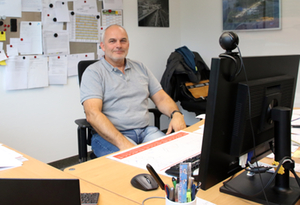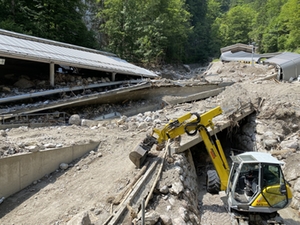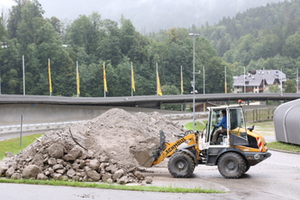Königssee artificial track after the flood / Interview track director Markus Aschauer

Königssee (FIL) Heavy rain and mudslides severely damaged the artificial ice track at Bavarian Königssee (GER) in the night from 17 to 18 July 2021. Parts of the 2021 World Championship’s track were swept away by water and debris, filled up and destroyed.
The track manager of the Lotto Bayern Eisarena Königssee and chairman of the FIL track construction commission Markus Aschauer reports on what happened and the plans for the future of the world's first artificial track for luge, bobsleigh and skeleton:
Mr Aschauer, Königssee was not only the first but also the most frequented artificial ice track in the world. What will happen to the sports operations at Königssee? Can the facility be rebuilt?
Markus Aschauer: "We hope that the track can be rebuilt. We have a commitment from the political side. But now the extent of the damage has to be assessed and the costs for reconstruction calculated. We want to know more in September. In any case, it will definitely be impossible to run sports in the coming winter. This will have a dramatic effect on junior and youth sports in particular. The young athletes already had massive restrictions due to the Covid 19 pandemic in the last season, and now they won't be able to train here in the coming winter either. We have great support from the Olympiaworld Innsbruck and want to organise regular training for our young athletes there. Innsbruck will even ice their track a week earlier for our squad. We are very grateful to our colleagues from Austria”.
Were you surprised by the international response from athletes, colleagues from other tracks, fans and friends?
Markus Aschauer: "It was very surprising and also very good for us that there is such a great response internationally for our track. All the other tracks around the world have offered help and support”.

How did you cope emotionally when you saw for yourself what was happening to “your” track?
Markus Aschauer: "I have to say that I was in shock at first. The devastation was very crass. Fortunately, we have very high safety standards at our track. We have divided our remote-controlled ammonia line into five sections with shut-off units. With only 0.3 bar pressure and the individual shut-off units, only a little, if any, ammonia could have escaped, this would then have immediately combined with all the water and the resulting ammonia spirit would have been harmless. Our ammonia tanks are made of steel and the basin underneath is concreted like a swimming pool and is completely tight. So I could rule out an ammonia accident. That was the most important thing on the night of the crisis. There was nothing else to do that night. I couldn't even get through with the tractor after the “Teufelsmühle” curve 5.
When I went to work in the morning, I found parts of the roof of Curve 3 down by Lake Königssee. Everywhere there was only rubble, mud and damage. From Monday I worked strictly according to plan, it went into clean-up mode. There was still a state of emergency for one day and therefore the Technical Assistance Organisation (THW) and the German Armed Forces (Bundeswehr) were able to work with us with large equipment that was not used or needed elsewhere and, above all for safety reasons, to restore the water passage under Curve 3. As of Tuesday, the state of emergency was lifted and the companies then had to be paid".
What happens next?
Markus Aschauer: "We are still cleaning up. About 100 athletes, from Olympic champions to junior athletes, have helped us. But we want to send an important signal to the world soon: We will now ice the start track and offer training internationally. Our refrigeration system is in order and we can offer start training".

What are the plans for the future?
Markus Aschauer: "The plan is that we want to sit down together in September. By then, the water management department should have a rough overview of what needs to be done. By then we should also have approximate costs, although the cost vagueness is certainly at least 20 per cent. When you start working, you can still find things that have also been washed free or are broken. Then we have to see how we can manage the reconstruction".
When do you expect to be able to build?
Markus Achauer: "I am sure that nothing major will happen in the coming winter. If I plan optimistically, we might be able to demolish defective parts of the track in March 2022. Then, step by step, we will have to work in parallel with the bidding and contracting of the other trades. The goal would be to have the youngsters back at Königssee for the 2022/23 season".
We wish you every success and thank you for the interview!









